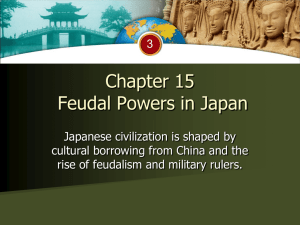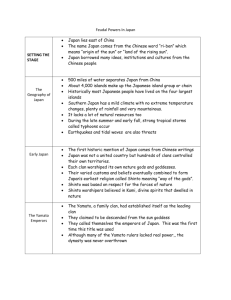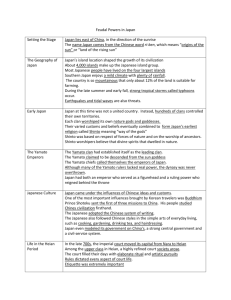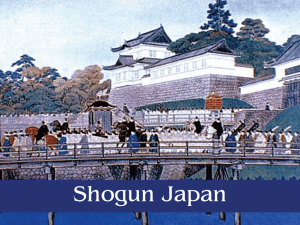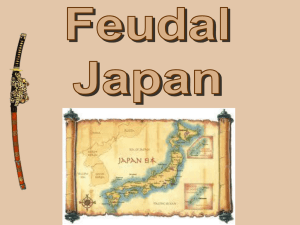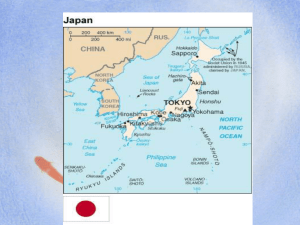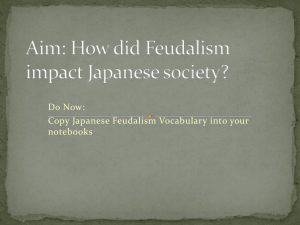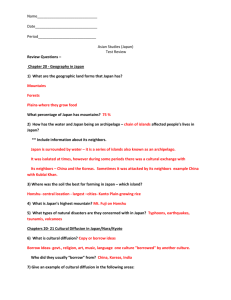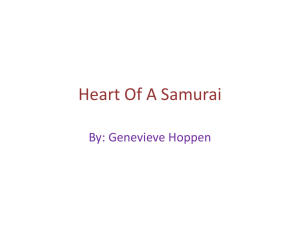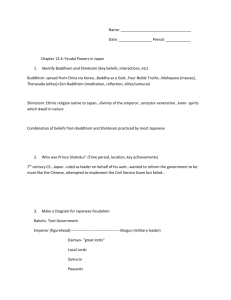Dramaturgy_for_Golden_Samurai
advertisement
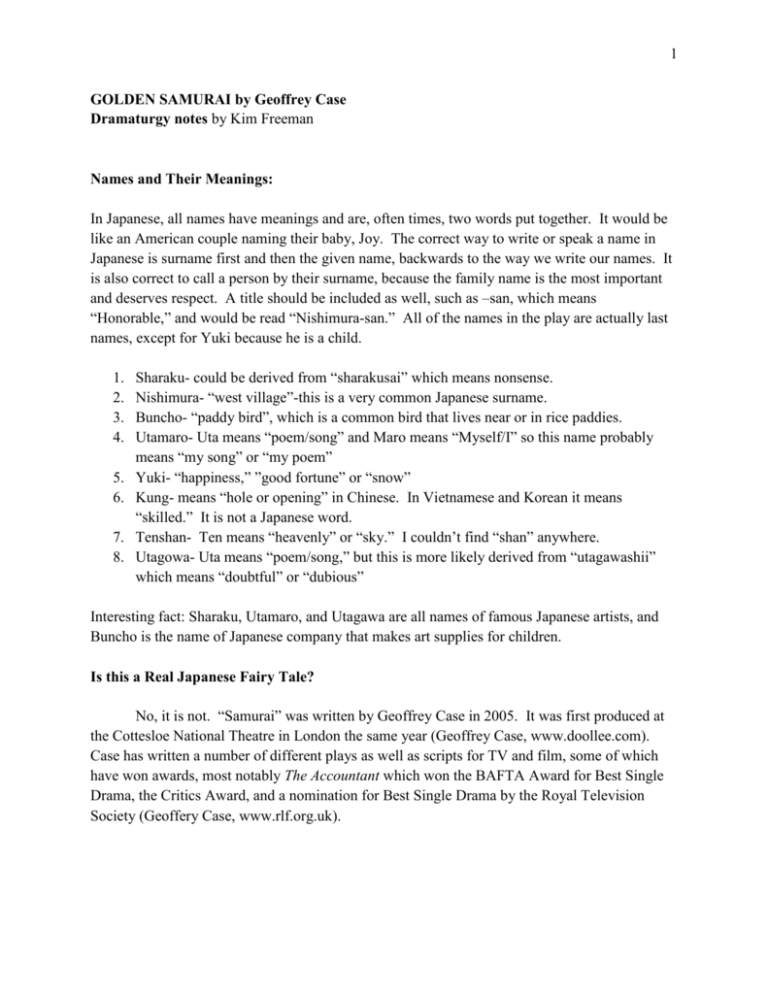
1 GOLDEN SAMURAI by Geoffrey Case Dramaturgy notes by Kim Freeman Names and Their Meanings: In Japanese, all names have meanings and are, often times, two words put together. It would be like an American couple naming their baby, Joy. The correct way to write or speak a name in Japanese is surname first and then the given name, backwards to the way we write our names. It is also correct to call a person by their surname, because the family name is the most important and deserves respect. A title should be included as well, such as –san, which means “Honorable,” and would be read “Nishimura-san.” All of the names in the play are actually last names, except for Yuki because he is a child. 1. 2. 3. 4. 5. 6. 7. 8. Sharaku- could be derived from “sharakusai” which means nonsense. Nishimura- “west village”-this is a very common Japanese surname. Buncho- “paddy bird”, which is a common bird that lives near or in rice paddies. Utamaro- Uta means “poem/song” and Maro means “Myself/I” so this name probably means “my song” or “my poem” Yuki- “happiness,” ”good fortune” or “snow” Kung- means “hole or opening” in Chinese. In Vietnamese and Korean it means “skilled.” It is not a Japanese word. Tenshan- Ten means “heavenly” or “sky.” I couldn’t find “shan” anywhere. Utagowa- Uta means “poem/song,” but this is more likely derived from “utagawashii” which means “doubtful” or “dubious” Interesting fact: Sharaku, Utamaro, and Utagawa are all names of famous Japanese artists, and Buncho is the name of Japanese company that makes art supplies for children. Is this a Real Japanese Fairy Tale? No, it is not. “Samurai” was written by Geoffrey Case in 2005. It was first produced at the Cottesloe National Theatre in London the same year (Geoffrey Case, www.doollee.com). Case has written a number of different plays as well as scripts for TV and film, some of which have won awards, most notably The Accountant which won the BAFTA Award for Best Single Drama, the Critics Award, and a nomination for Best Single Drama by the Royal Television Society (Geoffery Case, www.rlf.org.uk). 2 Tenth Century Japan The time frame from 794 to 1185 is known as the Heian period because the emperor moved the capital to his newly made city called Heian-Kyo, later known as Kyoto. The Heian period is also known as the “End of the Classical Era of Japan”, before moving into “Medieval Japan.” Up until this point, Japan had been reaching out to other countries and picking up influences from them, especially from China. Evidence of this influence can be seen in the city of Heian-Kyo, which was built using many Chinese principles, including a grid pattern for streets. However, at the beginning of the Heian period, there is a definite shift back to isolation and introspection. Art and literature flourished during the 400 plus years of peace that this era experienced. Famous novels and books such as “The Pillow Book” by Sei Shonagon and “The Tale of the Genji” by Murasaki Shikubu were written during this time. Contrary to popular belief, “samurai” did not exist during the 10th century. The term “Samurai” did not appear in text at all until the 12th century, but a warrior class was starting to immerge. Documents dating as early as the 7th century called for the recruitment of “strong fellows,” who were employed by feudal lords as warriors. It was considered a mark of honor to be skilled in riding, archery, and sword play (Turnbull, Samurai). Kumadori: Ritual and Makeup Make-up used by Kabuki actors is called Keshou. Kabuki actors use makeup to accentuate, and exaggerate facial features and to convey emotion without having to maintain that expression for the whole play. Kumadori is the over exaggerated, colorful form that most people think of when they imagine Japanese theatre. It was first introduced by the famous actor Danjuro I in 1673. The application of the makeup, called kao o tsukuru (“making a face”) is considered a psychological preparation for the performance, as the actor literally becomes the character (Make-up, www.creative-arts.net). The base is the white paint called oshiroi, which is made from rice powder; this covers the entire face and throat, but does not touch the back of the neck or the top of the ears. This was originally to keep makeup off of the wigs, but it came to be seen as attractive to have “pink” ears and neck. All of the colors used represent something specific about the characters. beni (deep red) anger, indignation, forcefulness, obstinacy beni (red) activeness, eagerness, passion, vigour usuaka (pink or pale red) cheerfulness, youthfulness, gaiety asagi (light blue) calmness, coolness, composure ai (indigo) melancholy, gloominess midori (very light green) Tranquility 3 murasaki (purple) sublimity, nobility, loftiness taisha (brown or burnt sienna) selfishness, egotism, dejection usuzumii (grey on chin) dreariness, cheerlessness sumi (black) fear, terror, fright, gloom The colors were also restricted to only a certain type of character. Deep red on a white face o used more frequently than any other and it expresses, anger, indignation, or rage mixed with cruelty. It can also represent characters with forceful personalities who have good qualities Pink o restricted to a small number of roles, one being that of the charming or amorous fox Indigo o second to deep red in usage and appears on the faces of villains and ghosts Brown o worn by villains among court nobles and by gods Purple, light green and gold o seldom used being restricted to characters such as that of the lion in Shakkyo, and the golden tiger in Ryuuko (Make-up). A tradition of Kumadori, is oshiguma, which the actor does after the play has finished. He would take a silk cloth and make a “print” of his Keshou design as a souvenir of his performance (Make-up). When Case’s Samurai was first performed, the actors used Kumadori to give all of the villagers constantly angry and outraged looks. 4 Works Cited Turnbull, Stephen R. Samurai: the Story of Japan’s Great Warriors. PRC Publishing Company. London, England. 2004 “Make-up”, http://www.creative-arts.net/kabuki/Breakdown/Make-up.htm “Geoffrey Case”, http://www.rlf.org.uk/fellowshipscheme/profile.cfm?fellow=203&menu=2 “Geoffrey Case”, http://www.doollee.com/PlaywrightsC/case-geoffrey.html


